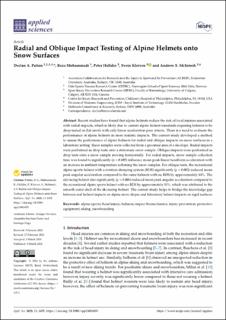| dc.contributor.author | Patton, Declan A. | |
| dc.contributor.author | Mohammadi, Reza | |
| dc.contributor.author | Halldin, Peter | |
| dc.contributor.author | Kleiven, Svein | |
| dc.contributor.author | McIntosh, Andrew S. | |
| dc.date.accessioned | 2024-03-18T07:27:27Z | |
| dc.date.available | 2024-03-18T07:27:27Z | |
| dc.date.created | 2023-04-27T13:14:01Z | |
| dc.date.issued | 2023 | |
| dc.identifier.citation | Applied Sciences. 2023, 13(6), Artikkel 3455. | en_US |
| dc.identifier.issn | 2076-3417 | |
| dc.identifier.uri | https://hdl.handle.net/11250/3122766 | |
| dc.description | This article is an open access article distributed under the terms and conditions of the Creative Commons Attribution (CC BY) license (https://creativecommons.org/licenses/by/4.0/). | en_US |
| dc.description.abstract | Recent studies have found that alpine helmets reduce the risk of focal injuries associated with radial impacts, which is likely due to current alpine helmet standards requiring helmets to be drop-tested on flat anvils with only linear acceleration pass criteria. There is a need to evaluate the performance of alpine helmets in more realistic impacts. The current study developed a method to assess the performance of alpine helmets for radial and oblique impacts on snow surfaces in a laboratory setting. Snow samples were collected from a groomed area of a ski slope. Radial impacts were performed as drop tests onto a stationary snow sample. Oblique impacts were performed as drop tests onto a snow sample moving horizontally. For radial impacts, snow sample collection time was found to significantly (p = 0.005) influence mean peak linear headform acceleration with an increase in ambient temperature softening the snow samples. For oblique tests, the recreational alpine sports helmet with a rotation-damping system (RDS) significantly (p = 0.002) reduced mean peak angular acceleration compared to the same helmets with no RDS by approximately 44%. The ski racing helmet also significantly (p = 0.006) reduced mean peak angular acceleration compared to the recreational alpine sports helmet with no RDS by approximately 33%, which was attributed to the smooth outer shell of the ski racing helmet. The current study helps to bridge the knowledge gap between real helmet impacts on alpine snow slopes and laboratory helmet impacts on rigid surfaces. | en_US |
| dc.language.iso | eng | en_US |
| dc.subject | alpine sports | en_US |
| dc.subject | head injury | en_US |
| dc.subject | helmets | en_US |
| dc.subject | impact biomechanics | en_US |
| dc.subject | injury prevention | en_US |
| dc.subject | protective equipment | en_US |
| dc.subject | skiing | en_US |
| dc.subject | snowboarding | en_US |
| dc.title | Radial and oblique impact testing of alpine helmets onto snow surfaces | en_US |
| dc.type | Peer reviewed | en_US |
| dc.type | Journal article | en_US |
| dc.description.version | publishedVersion | en_US |
| dc.rights.holder | © 2023 by the authors | en_US |
| dc.source.pagenumber | 11 | en_US |
| dc.source.volume | 13 | en_US |
| dc.source.journal | Applied Sciences | en_US |
| dc.source.issue | 6 | en_US |
| dc.identifier.doi | 10.3390/app13063455 | |
| dc.identifier.cristin | 2143824 | |
| dc.description.localcode | Institutt for idrettsmedisinske fag / Department of Sports Medicine | en_US |
| dc.source.articlenumber | 3455 | en_US |
| cristin.ispublished | true | |
| cristin.fulltext | original | |
| cristin.qualitycode | 1 | |
